Depth, width, roundness, and uniformity of facets determines the brilliance of a diamond. Of the 4 C's, the cut of a diamond is the only one that we can actually control. A rough stone in the hands of a skilled craftsman can be transformed into a gem of true beauty.
How the cut influences the brilliance of a diamond
 As light enters a diamond, it reflects off its many facets. This gives a diamond its brilliance and sparkle. The angles of the facets - in relation to the other facets on the top and bottom of a diamond - initially determine the quality of the cut. In addition, the top and bottom portions of the diamond must have the correct proportions in relation to each other. A stone that is cut too deep (or too shallow) will lose much of its brilliance, as shown in the diagram below. Finally, a well cut diamond will have a table, the flat upper surface of the diamond, with the correct size in relation to the overall size of the stone.
As light enters a diamond, it reflects off its many facets. This gives a diamond its brilliance and sparkle. The angles of the facets - in relation to the other facets on the top and bottom of a diamond - initially determine the quality of the cut. In addition, the top and bottom portions of the diamond must have the correct proportions in relation to each other. A stone that is cut too deep (or too shallow) will lose much of its brilliance, as shown in the diagram below. Finally, a well cut diamond will have a table, the flat upper surface of the diamond, with the correct size in relation to the overall size of the stone.
What does this mean? A well cut diamond will maximize the amount of light that reflects out of it. A poorly cut diamond allows the light to escape out its bottom and sides, reducing the overall brilliance of the diamond.
What makes up a diamond's cut?

Diameter: is the width of a diamond measured through its widest part, its girdle
Depth: is the height of a diamond measured from the table to the culet
Table: is the flat part on the top of the diamond and is also the largest facet on the stone. It is expressed as a percentage. Larger tables make a diamond look larger, but if too large will result in a shallow diamond which does not reflect light properly.
Girdle: is the outer edge of the top of the diamond and is its widest part. Girdles are described by their thickness and are best when not too thin or too thick.
Crown: is the portion of the diamond that extends from the table to the top of the girdle. Older cuts of diamonds often have a steeper crown angle, a smaller table, and a culet.
Culet: is the very bottom tip of the diamond. When the tip has any degree of a plane, it has a very small to medium culet which is a small facet. Culets are more common in older cut stones.
Pavillion: is the portion of the diamond that extends from the middle of the girdle to the bottom of the culet. It is expressed as a percentage. Too deep a pavilion will make a diamond look smaller and will affect its ability to reflect light properly.
